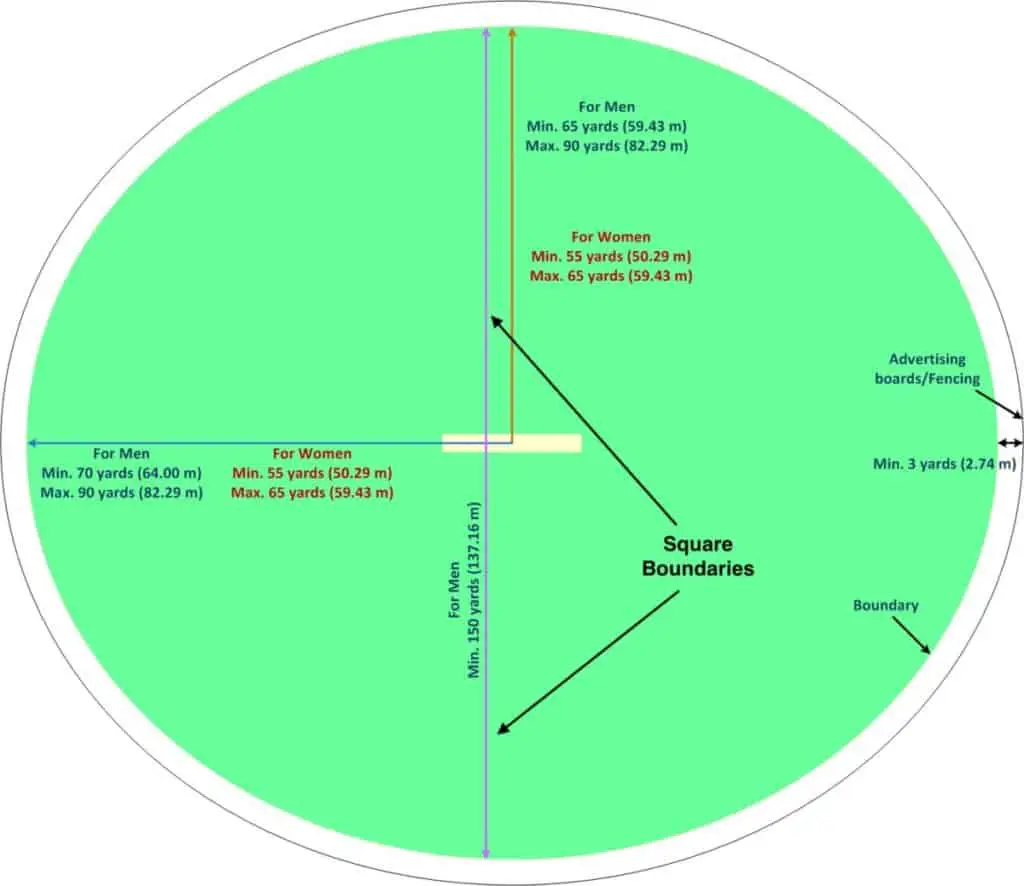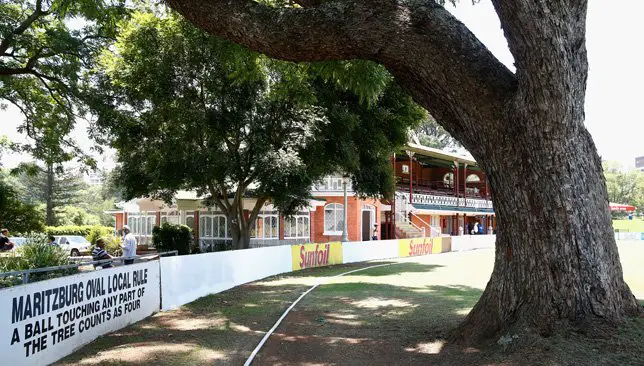When I first got involved with the game of Cricket, I always wondered how far does a batsman have to hit the ball in order to get six runs! What is a typical size of the cricket field and why do some grounds look smaller while others look big? So, in today’s article, we take a look at the size of a cricket field and some of the largest and smallest cricket grounds in the world.
But first, what is the size of a cricket ground? The size of a cricket ground (playing area) varies as its diameter can be in the range of 137.16 meters to 150 meters. The shortest boundary on a cricket field can be 59.43 meters from the cricket pitch, and the longest boundary can not exceed 82.29 meters. An international stadium typically has a minimum of 17,000 m2 of a grass field.
While this is a permitted range set by the International Cricket Council (ICC), most cricket grounds have a varying boundary size. Size of the playing area can also vary for women’s cricket matches. Let’s learn about it a bit more –
Cricket Ground Size & Dimensions

It is easy to understand the cricket ground sizes with the following table and a representative image (showcased above) –
For Men’s Cricket Matches –
| Criteria | Min. Length | Max. Length | Min. Diameter |
| Square Boundaries | 59.43 meters | 82.29 meters | 137.16 meters |
| Straight Boundaries | 64 meters | 82.29 meters | 137.16 meters |
Apart from the length of the boundary from the pitch, ICC has also set a standard distance of the fence/advertising board from the boundary. The advertising boards have to be at a minimum distance of 2.74 meters from the boundary.
Due to the varying diameters of the boundaries, the size of a cricket field is often oval than circular. In fact, the
Does the Ground Size vary based on the Format of the Cricket Match?
No. The size of a cricket ground does not vary based on the format of the cricket match.
Most international matches, limited or unlimited overs, are played in an international stadium. The size of a cricket stadium is much bigger than a football or an olympic stadium. Thus, these stadiums have to be custom-built.
There is also a set criterion for a stadium to qualify as an international cricket stadium. The size of a playing field including the length of the boundaries is one of the criteria, and the minimum requirements have to be followed.
Thus, most international cricket matches are held at stadiums that qualify the minimum criterion. Hence, ground size remains the same irrespective of the format of the game.
Is the Ground Size different for Women’s Cricket?
Yes, the size of the playing field is different for Women’s Cricket matches. Generally, the length of the boundaries is shorter than that of men’s cricket matches. This can be seen from the table below –
For Women’s Cricket Matches –
| Criteria | Min. Length | Max. Length | Min. Diameter |
| Square Boundaries | 50.29 meters | 59.43 meters | – |
| Straight Boundaries | 50.29 meters | 59.43 meters | – |
There is no minimum diameter required for boundaries.
Furthermore, the matches are held in the same stadium as that of men’s cricket matches. Just that the boundaries are set further inwards as compared to that of a men’s cricket match.
What is a Boundary on a Cricket Field?
Boundary, as the name suggest, is the extent of the playing area on a cricket field. A cricket match is played within the boundary.
Typically, a boundary is marked with a white line or a white rope. In international matches, these days boundaries are covered with soft advertising cushions that serve a dual purpose of advertising space and preventing injuries to a fielder diving for the ball.
In case white boundary lines or ropes are unavailable, other objects such as flags or posts can be used merely to highlight the boundaries. These objects are to be kept beyond the boundary.
What happens if there is an Object inside the Boundary?
The possibility of such incidents are rare. Almost all stadiums are build with international standards today.
But some old stadiums have had trees inside the playing area.

For such grounds, special rules come in to play. For instance, if the ball hits the tree, irrespective whether directly or after a bounce, it is considered a four. Furthermore, if the ball hits the tree and a fielder catches the ball, the batsman is not considered as out.
Additionally, if a person or an animal comes inside the boundary when the ball is in play and the ball hits a person or the animal, it is not considered as a boundary. This, however, is decided on a case-to-case basis by the umpire.
What are some of the Largest Cricket Ground in the World?
Cricket is an international game and there are several cricket stadiums across the world.
The largest cricket ground can be based on the following two criteria –
- Size of the boundary
- Capacity of the stadium
Let’s have a look at some of the largest grounds based on both the parameters.
Largest Cricket Ground based on Size of the Boundary
Here is a list of grounds with largest boundary size –
| No. | Ground Name | Country | Boundary Type | Size (in meters) |
| 1 | Sydney Cricket Ground (SCG) | Australia | Straight | 93.72 |
| 2 | Lords, London | England | Straight | 88.87 |
| 3 | The Wanderers, Johannesburg | South Africa | Straight | 86.76 |
| 4 | Melbourne Cricket Ground (MCG) | Australia | Square | 86.24 |
| 5 | SSC Colombo | Sri Lanka | Straight | 86.09 |
A point to note here would be that the above figures are indicative. On an actual match day, the boundary size can increase or decrease by upto 10 meters depending on the ground.
An interesting thing to note is that MCG by far has the highest square boundary. In fact, it is so huge that the audience is not used to seeing the ball not reach the boundary on the leg side. This also often creates a misconception that MCG has the longest boundary in the world.
Largest Cricket Grounds based on Capacity
The largeness of a cricket ground is often based on the capacity of the spectators. Based on this parameter, some of the largest cricket stadiums are as follows –
| No. | Stadium | Country | Capacity |
| 1 | Motera, Ahmedabad | India | 110,000 |
| 2 | Melbourne Cricket Stadium (MCG) | Australia | 101,024 |
| 3 | Eden Gardens, Kolkata | India | 66,000 |
| 4 | New Raipur Stadium | India | 65,000 |
| 5 | Perth Stadium | Australia | 60,000 |
An interesting thing to note is that Eden Gardens in Kolkata had a seating capacity of over 100,000. However, in order to match the international standards during the 2011 ODI World Cup, Eden Gardens underwent renovation and the capacity was reduced to 66,000 to accommodate the upgraded players dressing rooms and other facilities.

